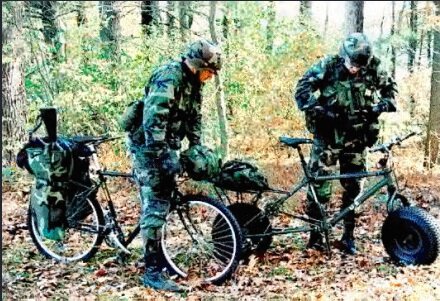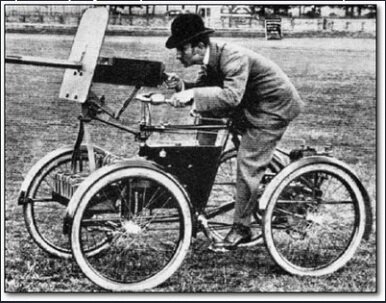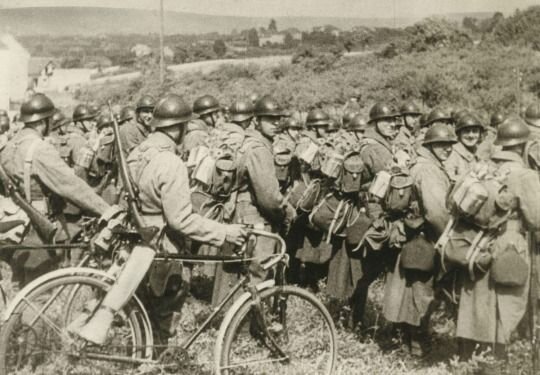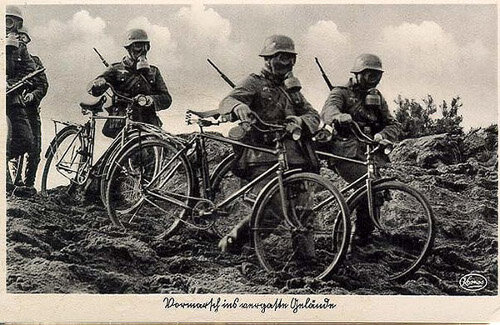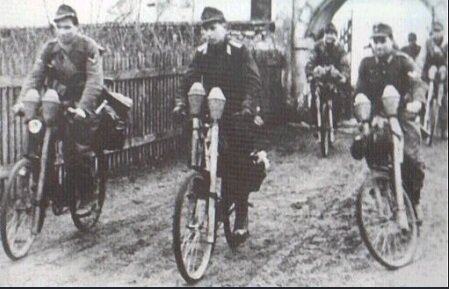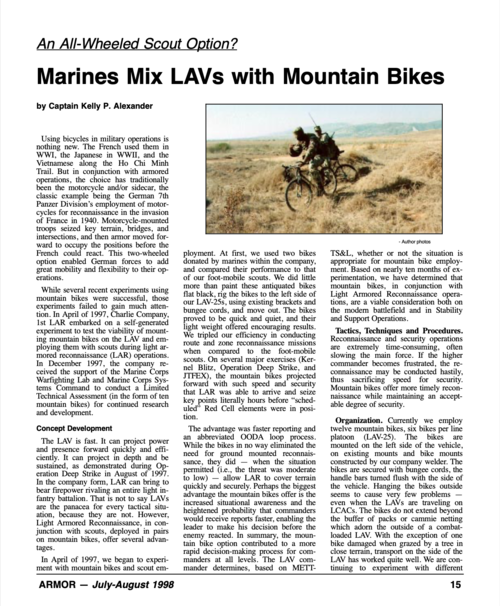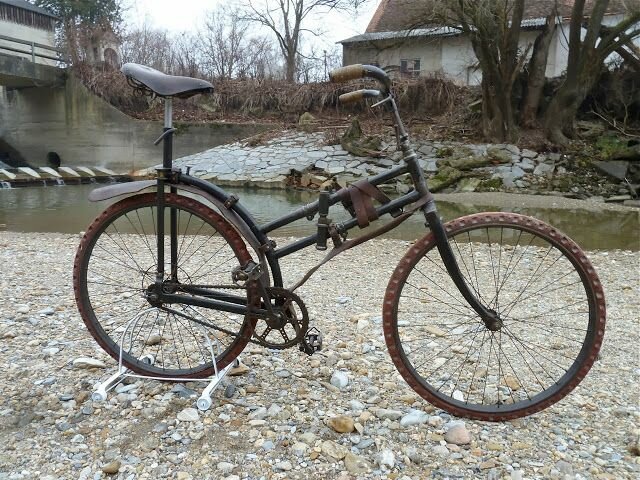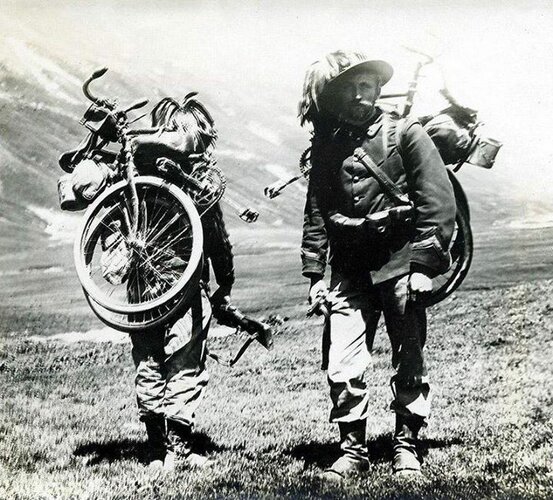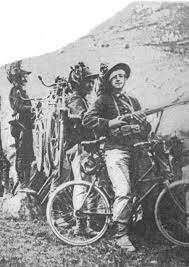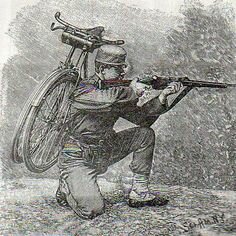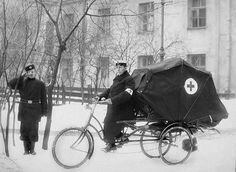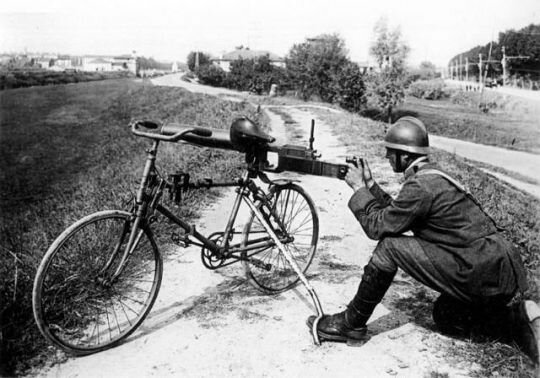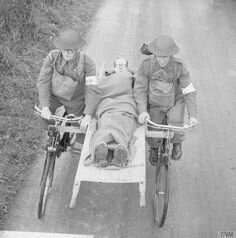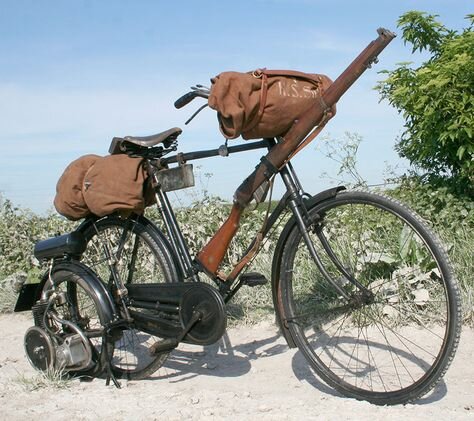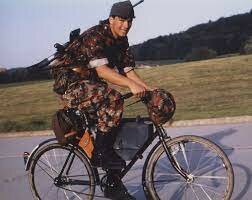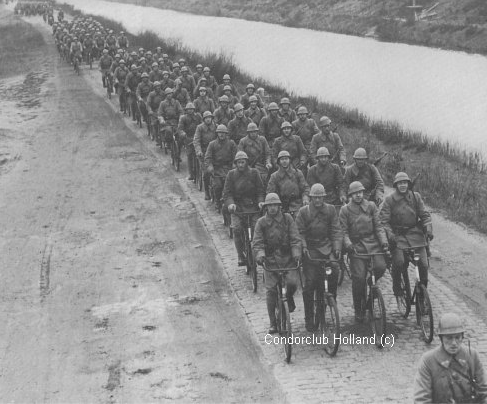You are using an out of date browser. It may not display this or other websites correctly.
You should upgrade or use an alternative browser.
You should upgrade or use an alternative browser.
Armies and bicycles
- Thread starter Grey Havoc
- Start date
- Joined
- 11 March 2012
- Messages
- 3,250
- Reaction score
- 3,179
Dear Kat Sun,
You have far more faith in Air Force accuracy than I. It is quite common for paratroopers to be dropped many miles from their target and have to hike over rough terrain to reach it. Linking up with equipment dropped separately may require hours or the rest of your life if those pesky enemies intervene.
You also have far more faith in HUMMV mobility than I. Consider that one of the funniest photographs to come out of Afghanistan was of a Spanish Army HUMMV jammed in a sunken road that was narrower than the HUMMV!
Hah!
Hah!
In many Third World countries, even dirt bikes and ATVs struggle to move along goat tracks.
You have far more faith in Air Force accuracy than I. It is quite common for paratroopers to be dropped many miles from their target and have to hike over rough terrain to reach it. Linking up with equipment dropped separately may require hours or the rest of your life if those pesky enemies intervene.
You also have far more faith in HUMMV mobility than I. Consider that one of the funniest photographs to come out of Afghanistan was of a Spanish Army HUMMV jammed in a sunken road that was narrower than the HUMMV!
Hah!
Hah!
In many Third World countries, even dirt bikes and ATVs struggle to move along goat tracks.
Kat Tsun
eeeeeeeeeeeeeee
- Joined
- 16 June 2013
- Messages
- 1,371
- Reaction score
- 1,778
Again, US SOCOM didn't mind Humvees or DPVs in Afghanistan. Rather than be obstinate and use horses, or bicycles, or whatever, they begged and pleaded with the USAF to airlift in motorization so they could actually carry useful equipment, like Javelins, GVLLDs, M2HBs, and other cool stuff. That won't fit on a bicycle.
Maybe Spanish Army drivers just need remedial training. One dude wrecking a truck isn't all that telling.
And yes, it was probably common for paratroopers to be dropped miles off target...in 1945. Nowadays paratroopers are dropped on large flat things. Usually runways. They're pretty hard to miss, and in fact they aren't missed: Even the worst missed jumps in Panama or Grenada landed within a few hundred feet of the main targets. Having larger payload aircraft and smaller jump chalks sort of solved the problem by itself: with fewer planes dropping more paratroopers, at lower altitudes (around 400-600 feet), they tend to stay together pretty well.
You'd land in some weeds or a bit of marsh but that was about it. No one got blown into the Canal or the ocean or anything. Either way, soldiers can't really march much these days, after all, and they don't. They carry much weight to walk very far and the bulk of this weight is usually protective equipment (body armor) and weaponry, so they can't easily just ditch it all.
Missing a target by "many miles" means you simply wait for someone to pick you up and you don't participate in the fight, because moving a "many miles" with 100-120 lbs of ammunition just isn't an option. Especially if it's a C-130 full of dudes. Luckily we have computer aided inertial navigation and GPS these days, so you literally can't miss the jump target. You can plug in a lat/long coordinate at an airbase and hit the target within a few hundred feet if you don't have GPS, like they did in the '80's, '90's, and '00's with Combat Talons. But that was before GPS became universal on all platforms and the pathfinder job kinda fell to the wayside I guess. Nowadays maybe only Argentina or something flies like that and everyone else just uses GPS and maps to find where they need to go.
Certainly if you land at the wrong airport on the other side of the town you'll be stealing peoples' cars in the parking lot to go to the right airport. Why would you walk at all?
There's simply not much of a reason for paratroopers to have bicycles, unless they need to go somewhere within about 30 or 40 kilometers distance, immediately after landing at a airbase, and there aren't enough trucks and cars to steal. Then you can just fly the bikes in on a couple pallets. Pretty easy. It's so niche of a utility it's not worth much discussion beyond that, because most places you go to will have people who have cars to steal cars from.
Maybe Spanish Army drivers just need remedial training. One dude wrecking a truck isn't all that telling.
And yes, it was probably common for paratroopers to be dropped miles off target...in 1945. Nowadays paratroopers are dropped on large flat things. Usually runways. They're pretty hard to miss, and in fact they aren't missed: Even the worst missed jumps in Panama or Grenada landed within a few hundred feet of the main targets. Having larger payload aircraft and smaller jump chalks sort of solved the problem by itself: with fewer planes dropping more paratroopers, at lower altitudes (around 400-600 feet), they tend to stay together pretty well.
You'd land in some weeds or a bit of marsh but that was about it. No one got blown into the Canal or the ocean or anything. Either way, soldiers can't really march much these days, after all, and they don't. They carry much weight to walk very far and the bulk of this weight is usually protective equipment (body armor) and weaponry, so they can't easily just ditch it all.
Missing a target by "many miles" means you simply wait for someone to pick you up and you don't participate in the fight, because moving a "many miles" with 100-120 lbs of ammunition just isn't an option. Especially if it's a C-130 full of dudes. Luckily we have computer aided inertial navigation and GPS these days, so you literally can't miss the jump target. You can plug in a lat/long coordinate at an airbase and hit the target within a few hundred feet if you don't have GPS, like they did in the '80's, '90's, and '00's with Combat Talons. But that was before GPS became universal on all platforms and the pathfinder job kinda fell to the wayside I guess. Nowadays maybe only Argentina or something flies like that and everyone else just uses GPS and maps to find where they need to go.
Certainly if you land at the wrong airport on the other side of the town you'll be stealing peoples' cars in the parking lot to go to the right airport. Why would you walk at all?
There's simply not much of a reason for paratroopers to have bicycles, unless they need to go somewhere within about 30 or 40 kilometers distance, immediately after landing at a airbase, and there aren't enough trucks and cars to steal. Then you can just fly the bikes in on a couple pallets. Pretty easy. It's so niche of a utility it's not worth much discussion beyond that, because most places you go to will have people who have cars to steal cars from.
Last edited:
- Joined
- 26 January 2011
- Messages
- 2,226
- Reaction score
- 645
Rather than Hummers which have very little load capacity, I think Landrovers are far more useful. I have seen 19 men pile into a Landrover so it is a vehicle which would fit the purposes of Paratroopers quite nicely. It would also fit into most or under most helicopters quite nicely.
Kat Tsun
eeeeeeeeeeeeeee
- Joined
- 16 June 2013
- Messages
- 1,371
- Reaction score
- 1,778
The truck itself isn't that important, TBF. You can probably cram 20 people into a Honda Civic if you don't care about the suspension.
That said IIRC the Rangers use Land Rovers but they call it something silly like Ranger Special Operations Vehicle. This replaced the sandrails.
That said IIRC the Rangers use Land Rovers but they call it something silly like Ranger Special Operations Vehicle. This replaced the sandrails.
- Joined
- 26 January 2011
- Messages
- 2,226
- Reaction score
- 645
Are they making Honda Civics bigger in the US?The truck itself isn't that important, TBF. You can probably cram 20 people into a Honda Civic if you don't care about the suspension.
That said IIRC the Rangers use Land Rovers but they call it something silly like Ranger Special Operations Vehicle. This replaced the sandrails.
Downunder they are a medium sized sedan.
Long wheel base Landrovers are what I am discussing. I don't believe the US Army uses that sized vehicle. Am I mistaken?
isayyo2
Lurker alert
- Joined
- 24 November 2011
- Messages
- 1,131
- Reaction score
- 2,331
Are they? It looks awfully similar to Mike Sparks reformist group, they were big proponents for light infantry mobility devices.American paratroopers mid-90sView attachment 658535
Maybe Here is a video , it could be the same unitAre they? It looks awfully similar to Mike Sparks reformist group, they were big proponents for light infantry mobility devices.American paratroopers mid-90sView attachment 658535
isayyo2
Lurker alert
- Joined
- 24 November 2011
- Messages
- 1,131
- Reaction score
- 2,331
The dynmicpara/blacktail defense/1st tactical studies groups are all Mike Sparks personalities. For every good idea they put out there's about five crazy ones behind itMaybe Here is a video , it could be the same unitAre they? It looks awfully similar to Mike Sparks reformist group, they were big proponents for light infantry mobility devices.American paratroopers mid-90sView attachment 658535View: https://www.youtube.com/watch?v=pkRaE3UEags
isayyo2
Lurker alert
- Joined
- 24 November 2011
- Messages
- 1,131
- Reaction score
- 2,331
Last edited:
German bicycles:
The Troop Bicycle of the German Wehrmacht: Paul Louis Johnson & John Fuller Ryan, George Stimson: 9780989364614: Amazon.com: Books
The Troop Bicycle of the German Wehrmacht [Paul Louis Johnson & John Fuller Ryan, George Stimson] on Amazon.com. *FREE* shipping on qualifying offers. The Troop Bicycle of the German Wehrmacht
www.amazon.com
- Joined
- 9 October 2009
- Messages
- 21,979
- Reaction score
- 13,640
On an tangent that may be of some interest:


Engineer Builds Self-Balancing Autonomous Bicycle In Spare Time - Slashdot
Hardware engineer Zhi Hui Jun built a bicycle that avoids obstacles and self-balances. Interesting Engineering reports: The engineer, who worked on the bicycle project in his spare time over the course of four months, crafted a self-balancing bicycle using an accelerometer and gyroscope sensors...
tech.slashdot.org
sat_dxer
ACCESS: Confidential
- Joined
- 8 July 2020
- Messages
- 76
- Reaction score
- 77
The late Jay Barbree & Martin Caidin wrote a book in 1974 called: Bicycles in war (Hawthorn Books).
Which may have been alluded to as a "secret space book" by Barbree in his auto-bio Live from Cape Canaveral (?)
Which may have been alluded to as a "secret space book" by Barbree in his auto-bio Live from Cape Canaveral (?)
Last edited:
On an tangent that may be of some interest:

Engineer Builds Self-Balancing Autonomous Bicycle In Spare Time - Slashdot
Hardware engineer Zhi Hui Jun built a bicycle that avoids obstacles and self-balances. Interesting Engineering reports: The engineer, who worked on the bicycle project in his spare time over the course of four months, crafted a self-balancing bicycle using an accelerometer and gyroscope sensors...tech.slashdot.org
Some form of gyroscope stabilized bicycle
An electric motorbike would be good for cav scouts to put in the M3, TBH.
yes and opportunity to fill with solar panels for filling in the field for better autonomy of movement
roguetechie
ACCESS: Restricted
- Joined
- 9 May 2011
- Messages
- 34
- Reaction score
- 14
They were also using hiluxes/Tacoma(or tundra can't remember which) including various standardized up armor kits etc nowThe truck itself isn't that important, TBF. You can probably cram 20 people into a Honda Civic if you don't care about the suspension.
That said IIRC the Rangers use Land Rovers but they call it something silly like Ranger Special Operations Vehicle. This replaced the sandrails.
Socom, the rangers, and etc are also heavily using electric dirt bikes in conjunction with the trick all wheel drive christini jp4 burner.
Now that big army is getting the Chevy Colorado based light vehicles some of these will probably stop being used.
All that said, there's a company called motoped which makes essentially a very light ICE engine dirt bike that you can put bicycle cranks on if you remove the pegs to pedal them.
These are an interesting halfway points which are more than good enough for the moment. Especially since there's a whole bunch of interesting technology that's about to be viable and cheap enough to make a great leap ahead.
perttime
I really did change my personal text
- Joined
- 30 March 2013
- Messages
- 311
- Reaction score
- 318
On an tangent that may be of some interest:

Engineer Builds Self-Balancing Autonomous Bicycle In Spare Time - Slashdot
Hardware engineer Zhi Hui Jun built a bicycle that avoids obstacles and self-balances. Interesting Engineering reports: The engineer, who worked on the bicycle project in his spare time over the course of four months, crafted a self-balancing bicycle using an accelerometer and gyroscope sensors...tech.slashdot.org
carvalho2008
Naval alternative projects
- Joined
- 20 November 2015
- Messages
- 452
- Reaction score
- 500
- Joined
- 11 March 2012
- Messages
- 3,250
- Reaction score
- 3,179
Good point about "transferrable power" to operate radios or other types of vehicles.
- Joined
- 11 March 2012
- Messages
- 3,250
- Reaction score
- 3,179
Dear Kat Tsun,
You have way more confidence in GPS and air force navigators than I do.
During one of my first military freefall jumps, our parachute training jumps were tacked on to the end of a C-130 mission to train young air force navigators. As I jogged (2 miles) back from the wrong end of CFB Edmonton's Lancaster Park, I ruminated on how much more fun it would be with a young navigator carrying the 40-ish (20 kg) parachute. This was before tandem was invented.
During my last day of jumping from RCAF DHC-5 Buffalos, I jumped when the green light came on and landed in a berry farm short of the airport. During our second jump, the green light illuminated, but I waited an extra 15 seconds - until we were over the airport - before exiting. The second jump landed us on the airport/landing zone target.
During war time, the USAF Space command plans to degrade GPS signals and who knows how accurate other navigation systems (LORAN, ILS, INS, etc.) will be.
I would prefer to land with a tandem bundle that has a bicycle strapped to one end. Bicycle wheels should be the same diameter (or smaller) as the freefall cylinder (about 1 yard or 1 meter). With quick-attach hubs, I hope to be rolling within a minute or 2 of landing. In a perfect world, a second pair of wheels would allow me to tow the cylinder along a hard-surface road (minimum smooth gravel).
You have way more confidence in GPS and air force navigators than I do.
During one of my first military freefall jumps, our parachute training jumps were tacked on to the end of a C-130 mission to train young air force navigators. As I jogged (2 miles) back from the wrong end of CFB Edmonton's Lancaster Park, I ruminated on how much more fun it would be with a young navigator carrying the 40-ish (20 kg) parachute. This was before tandem was invented.
During my last day of jumping from RCAF DHC-5 Buffalos, I jumped when the green light came on and landed in a berry farm short of the airport. During our second jump, the green light illuminated, but I waited an extra 15 seconds - until we were over the airport - before exiting. The second jump landed us on the airport/landing zone target.
During war time, the USAF Space command plans to degrade GPS signals and who knows how accurate other navigation systems (LORAN, ILS, INS, etc.) will be.
I would prefer to land with a tandem bundle that has a bicycle strapped to one end. Bicycle wheels should be the same diameter (or smaller) as the freefall cylinder (about 1 yard or 1 meter). With quick-attach hubs, I hope to be rolling within a minute or 2 of landing. In a perfect world, a second pair of wheels would allow me to tow the cylinder along a hard-surface road (minimum smooth gravel).
- Joined
- 16 April 2008
- Messages
- 9,608
- Reaction score
- 14,510
Dear Kat Tsun,
You have way more confidence in GPS and air force navigators than I do.
During one of my first military freefall jumps, our parachute training jumps were tacked on to the end of a C-130 mission to train young air force navigators. As I jogged (2 miles) back from the wrong end of CFB Edmonton's Lancaster Park, I ruminated on how much more fun it would be with a young navigator carrying the 40-ish (20 kg) parachute. This was before tandem was invented.
During my last day of jumping from RCAF DHC-5 Buffalos, I jumped when the green light came on and landed in a berry farm short of the airport. During our second jump, the green light illuminated, but I waited an extra 15 seconds - until we were over the airport - before exiting. The second jump landed us on the airport/landing zone target.
During war time, the USAF Space command plans to degrade GPS signals and who knows how accurate other navigation systems (LORAN, ILS, INS, etc.) will be.
I would prefer to land with a tandem bundle that has a bicycle strapped to one end. Bicycle wheels should be the same diameter (or smaller) as the freefall cylinder (about 1 yard or 1 meter). With quick-attach hubs, I hope to be rolling within a minute or 2 of landing. In a perfect world, a second pair of wheels would allow me to tow the cylinder along a hard-surface road (minimum smooth gravel).
The US has not degraded GPS in any recent war -- it's far too important for civilian users.
carvalho2008
Naval alternative projects
- Joined
- 20 November 2015
- Messages
- 452
- Reaction score
- 500
Dear Kat Tsun,
You have way more confidence in GPS and air force navigators than I do.
During one of my first military freefall jumps, our parachute training jumps were tacked on to the end of a C-130 mission to train young air force navigators. As I jogged (2 miles) back from the wrong end of CFB Edmonton's Lancaster Park, I ruminated on how much more fun it would be with a young navigator carrying the 40-ish (20 kg) parachute. This was before tandem was invented.
During my last day of jumping from RCAF DHC-5 Buffalos, I jumped when the green light came on and landed in a berry farm short of the airport. During our second jump, the green light illuminated, but I waited an extra 15 seconds - until we were over the airport - before exiting. The second jump landed us on the airport/landing zone target.
During war time, the USAF Space command plans to degrade GPS signals and who knows how accurate other navigation systems (LORAN, ILS, INS, etc.) will be.
I would prefer to land with a tandem bundle that has a bicycle strapped to one end. Bicycle wheels should be the same diameter (or smaller) as the freefall cylinder (about 1 yard or 1 meter). With quick-attach hubs, I hope to be rolling within a minute or 2 of landing. In a perfect world, a second pair of wheels would allow me to tow the cylinder along a hard-surface road (minimum smooth gravel).
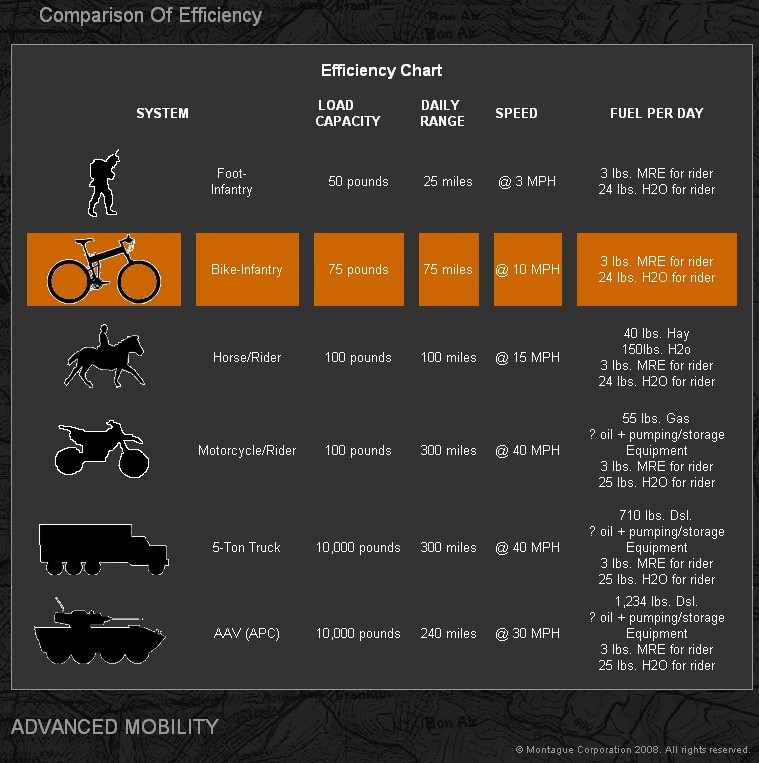
carvalho2008
Naval alternative projects
- Joined
- 20 November 2015
- Messages
- 452
- Reaction score
- 500
Similar threads
-
-
-
A SURVEY OF THE LITERATURE ON LIMITED STRATEGIC WAR AND STRATEGIC NUCLEAR WAR..
- Started by Grey Havoc
- Replies: 1
-
AIR BASE GROUND DEFENSE: AN HISTORICAL PERSPECTIVE AND VISION FOR THE 1990S
- Started by Grey Havoc
- Replies: 0
-

